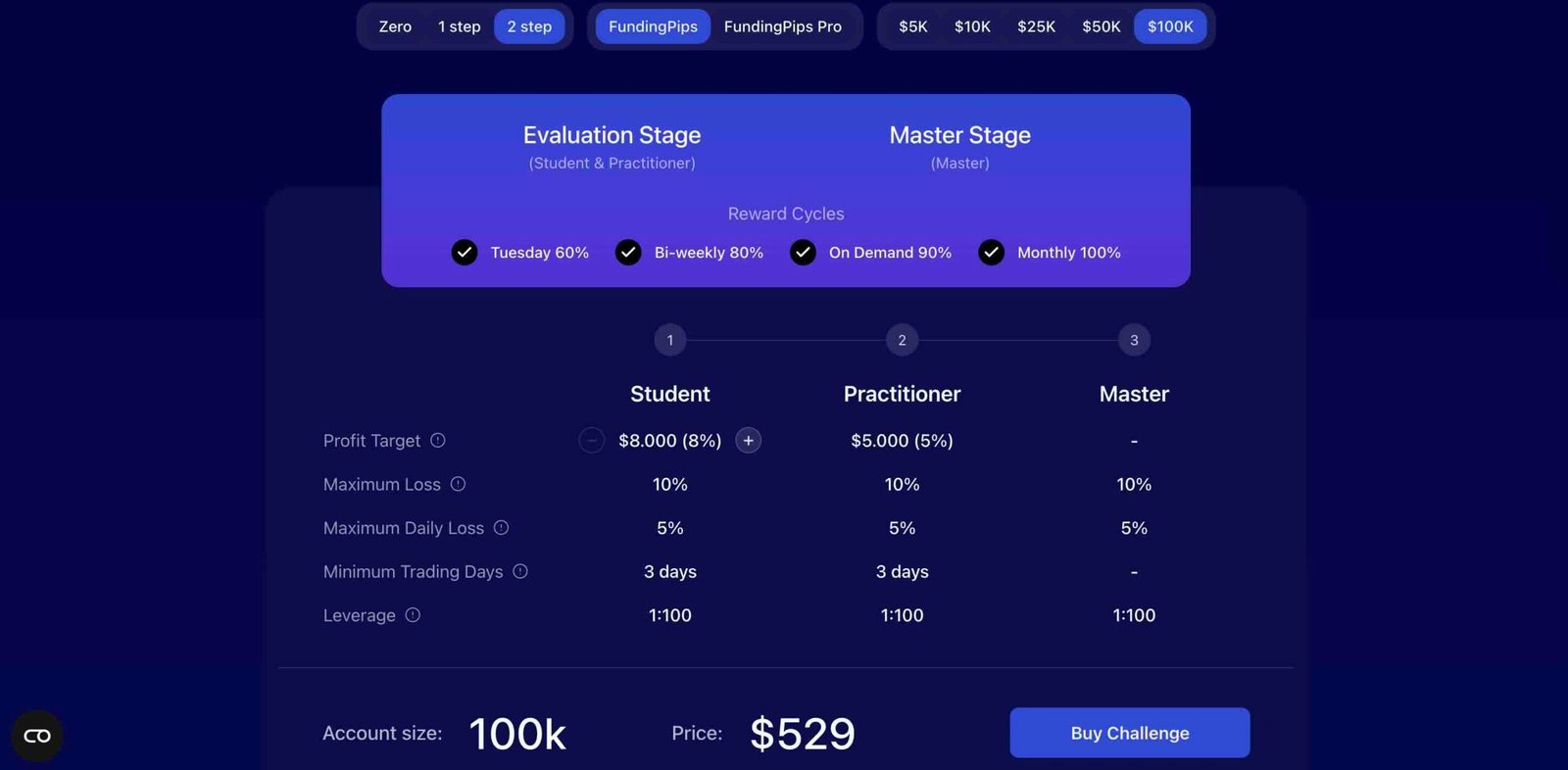Is prop firm trading profitable? Every trader asks this question at some point. You see the ads: trade a $100k account, keep 80% of profits, get paid every month. Sounds like free money, right?
The truth is, prop firm trading can be profitable. But only if you know how to manage the hidden parts of it. I’m talking about risk, fees, commissions, and the mental game. Passing a challenge is one thing. Turning that funded account into steady payouts is something else.
I’ve traded with multiple prop firms, and I can tell you this: there’s money to be made. But it’s not automatic. Without a real plan and a strategy, most traders end up paying more in fees than they ever withdraw.
In this post, I’ll break down the real costs, the potential rewards, and what actually decides if prop firm trading is profitable or not.
- Prop firm trading can be profitable, but only if you manage risk and follow the rules.
- Fees, commissions, and resets often eat into profits if you don’t track them carefully.
- Profit potential comes from larger accounts, high profit splits, and scaling plans.
- Discipline and consistency matter more than chasing big wins.
- A clear plan and strategy are what separate profitable traders from those who lose money.
The Real Costs of Prop Firm Trading
Trading prop firm capital isn’t free. Before you think about profits, you need to think about costs, and the first one is the challenge fee. Depending on the account size, it can run from 50 dollars to well over a thousand. And, if you fail, you pay again. Add resets and retries, and those numbers pile up quickly.
Then you’ve got spreads and commissions. They might look small at first, but over dozens of trades, they eat into your profits. If you don’t factor them in, you’re lying to yourself about what you’re really making.
Some prop firms also have hidden costs. Things like add-ons, platform fees, or stricter payout rules that force you to hold off on withdrawals. If you don’t read the fine print, you’ll be shocked when your “profit” doesn’t show up in your bank account.
That’s why many traders fail to turn a profit. They ignore the costs and think the account balance equals money in their pocket. Well, it doesn’t.
The Profit Potential
Now let’s look at the upside. The main reason traders go for prop firm challenges is access to capital. Instead of risking $1,000 of your own money, you can trade $50k, $100k, or even more. That’s the real draw.
Profit splits are another big selling point. Many firms let you keep 80% to 90% of profits. On a $100k account, even a small monthly gain can mean a decent payout. For example, make 5% in a month, that’s $5,000. With an 80% split, you take home $4,000. That’s a huge difference compared to trading a small personal account.
Some firms also offer scaling plans. If you trade consistently and protect capital, they’ll increase your balance over time. That means more potential profits without you putting in more of your own money.
So yes, the potential is there. But it only pays out if you can meet the rules and trade with control.
You can try risk-free prop firm trading using the FTMO free trial, and see if it fits you or not.
What Really Decides Profitability
This is where most traders get it wrong. Profitability in prop firm trading isn’t just about hitting targets. You should manage both yourself and your account.
The biggest factor is obviously the risk. If you don’t respect drawdown rules, you won’t last long enough to see a payout. Proper position sizing and keeping losses small, that’s the way to build something for the long-term.
Then there’s having a plan. You can’t show up on the charts and execute whenever you want. A solid strategy, tested and proven, is the only way to stay consistent. Prop firms aren’t impressed by one big win. They want steady results.
Consistency is key. A trader who makes 2% month after month will outlast the one swinging for 20% and blowing accounts. Small, repeatable gains are what get you scaled up and paid. And in some cases, you should also abide by certain prop firm consistency rules, or you will fail.
And finally, mindset. Trading a $100k account feels different than trading $1k of your own. The numbers are bigger, the pressure is heavier. If you don’t learn to think in percentages, you’ll choke on the size.
Example: Trading a FundingPips Account
Let’s take FundingPips as an example. Say you buy a $100k account. The fee for that account isn’t cheap. It’s somewhere around $500 for a 2-step challenge at the time of writing this post. So, the pressure is on from day one.

Now, if you play it smart, the math works in your favor. Let’s say you aim for a steady 5% gain in a month. That’s $5,000 profit. With an 80–90% profit split, you’re taking home $4,000 to $4,500. Most prop firms also refund your challenge fee, making it a $5,000 payout, with $4,500 pure profit.
But flip the script. You get greedy, risk too much, or overtrade, and hit the drawdown limit. One bad trade or a string of losses can make you lose your funded account. So, not only do you lose the chance to scale, but you’ll also lose the challenge fee.
Same account. Same rules. One trader makes a payout, the other blows up. The difference isn’t luck. It’s risk management and sticking to a proper plan.
So, Is Prop Firm Trading Profitable?
The short answer is yes. Prop firm trading can be profitable. But not for everyone.
You must manage risk and stick to a plan. That’s the only way you can build real income from it. There are shortcuts like prop firm passing services, but even they won’t continue trading on your account after passing the challenge.
Moreover, without discipline, it’s like a money pit. You’ll spend tons of your money on challenges and resets, only to blow accounts before seeing a payout. That’s why most traders walk away thinking prop firms are a scam. In reality, they just weren’t prepared.
At Traders Fund Hub, we’ll help you get there. Our experts publish valuable insights, prop firm reviews, and even articles about trading strategies that can help you become a profitable funded trader. So, you’ve definitely come to the right place.
Tips to Get Profitable in Prop Firm Trading
If you want to actually see profits with prop firms, you need more than just a good strategy. Here are a few tips to keep in mind:
- Start with a firm that fits your budget. If cost is a concern, look into our cheapest prop firms list so you don’t burn too much on fees before you’re consistent.
- Keep risk small. Never raise your risk just because your account size is bigger. Stick to the same percentage per trade.
- Focus on steady results. Consistency is what unlocks scaling and payouts. Don’t chase that one big month to satisfy your ego or to post it on social media.
- Consider faster access to capital. Some traders do better with instant funding prop firms, since they can start trading right away without long evaluations.
- Always track your trades. A simple journal helps you spot mistakes and build discipline over time.
- Backtest. Test your strategy on historical data. You can use a simple Excel or Google sheet, or dedicated software like FX Replay to analyze your performance.
Conclusion
Prop firm trading isn’t a guaranteed paycheck. But it’s a system that can reward discipline, and, of course, punish recklessness. The fees and strict rules make sure only consistent traders survive.
So, if you’ve got a plan, know how to manage risk, and trade with patience, then yes: chances are prop firm trading is profitable for you. In fact, it can be far more profitable than trading your own small account. But if you go in without control, it’ll cost you more than it pays.




